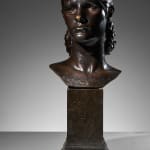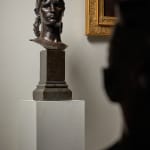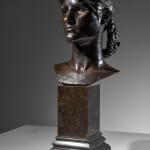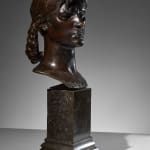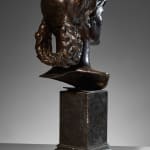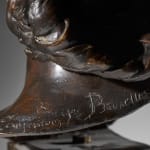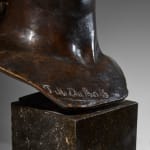Paul Du Bois
Further images
Paul Du Bois was born in Aywaille (commune in Belgium) on 21 September 1859 into a family of merchants his father (Hyacinthe Dubois) envisaged a career as a merchant for his son.
As the young man really had no interest in this kind of activity and preferred to spend his free time drawing and modelling he eventually got permission from his father to enrol at the Académie des Beaux-Arts in Brussels. There he studied ornamental sculpture under
Louis François Lefevre (from 1878 to 1880), which were based on the classical style of Jean-Joseph Jacquet. He continued his training under Eugène Simonis and already at the age of 23 (in 1882) participated in the Salon d'Anvers.
Two years later, in 1884, he won the Godecharle Prize with a work entitled "Hippomenes." He undertook a number of educational trips that allowed him to refine his aesthetic judgement, including trips to Paris and London. His meeting with Charles Van der Stappen (who established a free studio in March 1882) marked the beginning of a close friendship and defined a formal path that would underpin his interest in Italy and the Renaissance.
In the late 19th century, Brussels was a beacon of creative adventure. The Société Libre des Beaux-Art was founded in 1868.
in 1883 the Paul Du Bois would become one of the founding members of the XX group.
The sculptor championed the group, which positioned itself as a fable-like laboratory in which artistic creation could develop unhindered. He also participated in the activities of Libre Esthétique.
In the wake of Arts & Crafts and in the wake of thinking about the need to develop craft production that would change the industrial model by bringing art and industry together, decorative arts were present at the XX exhibitions.
Du Bois (who was closely involved in the scenography of the exhibitions) mixed objects, paintings and sculptures to create a new style.
His interest in decorative art is reflected in the artist's work, which combines sculpture with object-making. In particular, he created inkwells, matchboxes, candlesticks, brooches, salt shakers, water jugs, rice powder boxes, belt buckles, etc.
Around the turn of the nineteenth to the twentieth century, he placed several of his works in public spaces. Some of his sculptures adorn the facades of the Grand Place in Brussels, such as "La Renommée" (1898).
For the town hall in Saint-Gilles, he created "l'Électricité" (1902-1905) and "l'Éloquence et "La Fécondité" (1904-1905) , placed atop the Triumphal Arches of the Cinquantenaire Park in Brussels. Displayed in urban settings, this sculpture is dominated by the female figure. The semi-nude body reveals, through draping, a play of volumes that imposes spacious and generous forms.
Paul Du Bois was considered "a sculptor of women": he realised a somewhat detached portrait, realistic enough for the model to recognise herself, idealised enough for her to feel flattered. Free variations on the woman theme continued throughout his career, in busts, figurines, statues and utensils.
As allegory, symbol or simple figurative subject, the woman is always present in his work.
"l'été" (n.d., Administration communale, Uccle), "Femme assise" (n.d. ), "La charmeuse" (1886, Musée communale des Beaux-Arts d'Ixelles), "Le jour" (1889), "Femme se peignant" (before 1903, Musée communale des Beaux-Arts d'Ixelles), "Sérénité" (1907), "La guirlande" (1914, Musées royaux des Beaux-Arts de Belgique, Brussels) testify to a form evolving between realism and classicism. Although the sculptor allows sensuality to emerge, the surface remains quite smooth.
For Paul Du Bois, the female body expresses a carnal appearance. He assumes a serenity expressed without excess. The material was conventional and the technique academic.
He passed on this technique through the courses he taught, first at l'Académie de Mons (1900) and then at l'Académie de Bruxelles (1902).
His highly controlled work, which was undoubtedly not daring, was recognised by the Académie royale de Belgique, where he was elected correspondent of the Classe des Beaux-Arts (1932).
Paul Du Bois publicised his artistic creation through public institutions and commercial venues. Salons, museums and galleries became forums where artists could test themselves and gain a certain legitimacy. Although he was not a founding member of the Centre d'Art of Uccle, the artist regularly participated in its annual events for many years.

Irma Sèthe
Irma Sèthe was the daughter of Gérard Sèthe (1827-1893), a textile merchant, and Louise Frédérique Seyberth (1847-1923). She had two older sisters: Maria (1867-1943), who married the renowned Belgian architect, painter and designer, Henry van de Velde in 1894, and Alice, who married the Belgian sculptor Paul Du Bois. Irma also had a younger brother, Walter (1878-1937), an engineer.
Irma Sèthe was introduced to the world of music by her mother at an early age, and at the age of five she began her apprenticeship with Ottomar Jokisch (1841-1901). During the summer of 1885, the young girl continued her violin training with the German violinist August Wilhelmj.
j.







